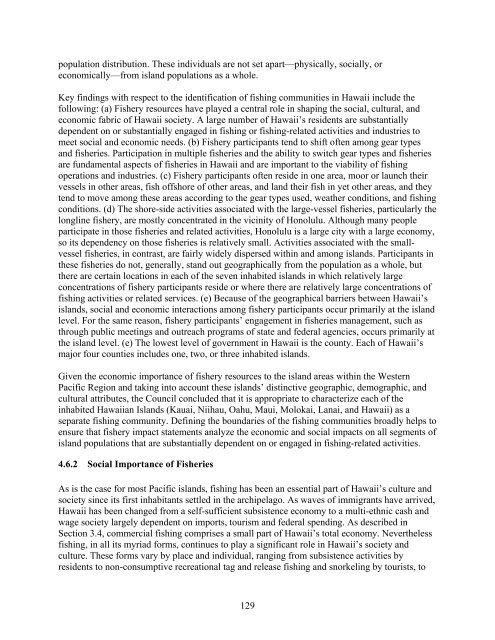Hawaii FEP - Western Pacific Fishery Council
Hawaii FEP - Western Pacific Fishery Council
Hawaii FEP - Western Pacific Fishery Council
You also want an ePaper? Increase the reach of your titles
YUMPU automatically turns print PDFs into web optimized ePapers that Google loves.
population distribution. These individuals are not set apart—physically, socially, oreconomically—from island populations as a whole.Key findings with respect to the identification of fishing communities in <strong>Hawaii</strong> include thefollowing: (a) <strong>Fishery</strong> resources have played a central role in shaping the social, cultural, andeconomic fabric of <strong>Hawaii</strong> society. A large number of <strong>Hawaii</strong>’s residents are substantiallydependent on or substantially engaged in fishing or fishing-related activities and industries tomeet social and economic needs. (b) <strong>Fishery</strong> participants tend to shift often among gear typesand fisheries. Participation in multiple fisheries and the ability to switch gear types and fisheriesare fundamental aspects of fisheries in <strong>Hawaii</strong> and are important to the viability of fishingoperations and industries. (c) <strong>Fishery</strong> participants often reside in one area, moor or launch theirvessels in other areas, fish offshore of other areas, and land their fish in yet other areas, and theytend to move among these areas according to the gear types used, weather conditions, and fishingconditions. (d) The shore-side activities associated with the large-vessel fisheries, particularly thelongline fishery, are mostly concentrated in the vicinity of Honolulu. Although many peopleparticipate in those fisheries and related activities, Honolulu is a large city with a large economy,so its dependency on those fisheries is relatively small. Activities associated with the smallvesselfisheries, in contrast, are fairly widely dispersed within and among islands. Participants inthese fisheries do not, generally, stand out geographically from the population as a whole, butthere are certain locations in each of the seven inhabited islands in which relatively largeconcentrations of fishery participants reside or where there are relatively large concentrations offishing activities or related services. (e) Because of the geographical barriers between <strong>Hawaii</strong>’sislands, social and economic interactions among fishery participants occur primarily at the islandlevel. For the same reason, fishery participants’ engagement in fisheries management, such asthrough public meetings and outreach programs of state and federal agencies, occurs primarily atthe island level. (e) The lowest level of government in <strong>Hawaii</strong> is the county. Each of <strong>Hawaii</strong>’smajor four counties includes one, two, or three inhabited islands.Given the economic importance of fishery resources to the island areas within the <strong>Western</strong><strong>Pacific</strong> Region and taking into account these islands’ distinctive geographic, demographic, andcultural attributes, the <strong>Council</strong> concluded that it is appropriate to characterize each of theinhabited <strong>Hawaii</strong>an Islands (Kauai, Niihau, Oahu, Maui, Molokai, Lanai, and <strong>Hawaii</strong>) as aseparate fishing community. Defining the boundaries of the fishing communities broadly helps toensure that fishery impact statements analyze the economic and social impacts on all segments ofisland populations that are substantially dependent on or engaged in fishing-related activities.4.6.2 Social Importance of FisheriesAs is the case for most <strong>Pacific</strong> islands, fishing has been an essential part of <strong>Hawaii</strong>’s culture andsociety since its first inhabitants settled in the archipelago. As waves of immigrants have arrived,<strong>Hawaii</strong> has been changed from a self-sufficient subsistence economy to a multi-ethnic cash andwage society largely dependent on imports, tourism and federal spending. As described inSection 3.4, commercial fishing comprises a small part of <strong>Hawaii</strong>’s total economy. Neverthelessfishing, in all its myriad forms, continues to play a significant role in <strong>Hawaii</strong>’s society andculture. These forms vary by place and individual, ranging from subsistence activities byresidents to non-consumptive recreational tag and release fishing and snorkeling by tourists, to129












